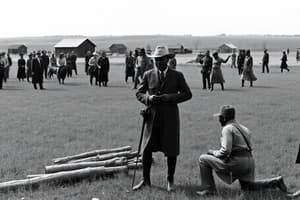Podcast
Questions and Answers
What was the main topic of the Lincoln-Douglas Debates?
What was the main topic of the Lincoln-Douglas Debates?
- Foreign relations with Europe
- The expansion of slavery (correct)
- Economic policies in the North
- State rights versus federal authority
What did John Brown's Raid at Harpers Ferry aim to achieve?
What did John Brown's Raid at Harpers Ferry aim to achieve?
- Negotiating peace with Southern states
- Inspiring a slave rebellion (correct)
- Establishment of a new government
- Territorial expansion for abolitionists
What was a significant outcome of the 1860 election of Abraham Lincoln?
What was a significant outcome of the 1860 election of Abraham Lincoln?
- The end of the Civil War
- Increased Southern support for the Union
- The unification of the Democratic Party
- Triggering the first wave of secession (correct)
What characterized the constitution of the Confederate States of America?
What characterized the constitution of the Confederate States of America?
Which of the following compromises aimed at preventing the collapse of the Union ultimately failed?
Which of the following compromises aimed at preventing the collapse of the Union ultimately failed?
What was a primary economic difference between the North and South leading up to the Civil War?
What was a primary economic difference between the North and South leading up to the Civil War?
What was the purpose of the Wilmot Proviso introduced in 1846?
What was the purpose of the Wilmot Proviso introduced in 1846?
What significant outcome did the Compromise of 1850 achieve?
What significant outcome did the Compromise of 1850 achieve?
What did the Dred Scott decision establish regarding African Americans?
What did the Dred Scott decision establish regarding African Americans?
Which party was formed in 1848 in opposition to the expansion of slavery?
Which party was formed in 1848 in opposition to the expansion of slavery?
Flashcards are hidden until you start studying
Study Notes
The Union in Crisis
- Division and Tensions:
- The North developed an industrial economy, while the South remained dependent on agriculture and slavery.
- This economic divergence fueled escalating tensions between the North and South, ultimately leading to the Civil War.
Slavery and Expansion
- Wilmot Proviso:
- This 1846 proposal aimed to prohibit slavery in territories acquired from Mexico.
- It was ultimately defeated, but its failure heightened the debate over slavery's future.
Growth of Anti-Slavery Sentiment
- Free-Soil Party:
- Formed in 1848, this party advocated for a policy of "Free soil, Free speech, Free labor, and Free men."
- They opposed the expansion of slavery into new territories.
Compromise and Conflict
- Compromise of 1850:
- Admitted California as a free state and allowed popular sovereignty (allowing residents to choose regarding slavery) in other territories.
- It also included the Fugitive Slave Act, which enforced the return of escaped slaves to their owners, sparking fierce resistance in the North.
Political Shifts
-
Republican Party Formation:
- Established in 1854, the Republican Party quickly gained political power in the North.
- It was committed to preventing slavery from expanding into new territories.
-
Dred Scott Decision:
- The Supreme Court's 1857 ruling declared that African Americans were not citizens and Congress could not ban slavery in territories.
- This landmark decision deepened divisions about slavery and intensified tensions between the North and South.
Debates and Division
-
Lincoln-Douglas Debates:
- In 1858, Abraham Lincoln and Stephen Douglas, both running for the U.S. Senate, clashed over the issue of slavery.
- Lincoln's position of opposing the expansion of slavery gained nationwide attention.
-
John Brown's Raid:
- In 1859, abolitionist John Brown's failed raid on Harpers Ferry, Virginia, attempted to ignite an uprising against slavery.
- While his effort was unsuccessful, it solidified his place as an anti-slavery martyr and fueled sectional tensions.
The Path to Secession
-
Democratic Party Division:
- Tensions over slavery led to a split within the Democratic Party in 1860.
- This division resulted in the nomination of two separate candidates, further fracturing the political landscape.
-
Lincoln's Election:
- The election of Abraham Lincoln in 1860, despite not having Southern support, sparked the first wave of Southern secession.
- South Carolina was the first state to secede.
-
Confederation Formation:
- Seven Southern states formed the Confederate States of America in 1861.
- Their constitution guaranteed slavery and reinforced state sovereignty.
Failed Peace Efforts
- Crittenden Compromise and Peace Convention:
- Last-minute compromises, like the Crittenden Compromise and a secret peace convention, were unsuccessful in preventing the collapse of the Union.
Studying That Suits You
Use AI to generate personalized quizzes and flashcards to suit your learning preferences.




